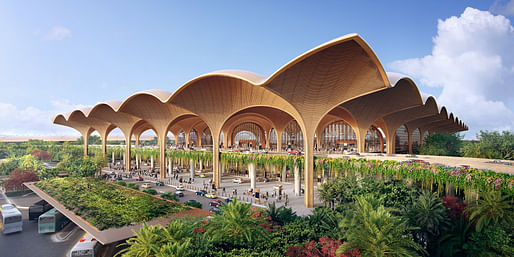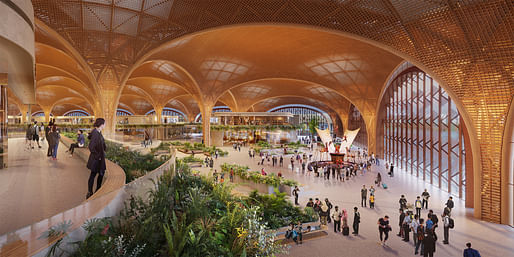
Construction is underway at Foster + Partners’ Techo International Airport in Cambodia. Located 16 miles south of central Phnom Penh, the project seeks to embody “a strong sense of place, drawing inspiration from one of the oldest civilizations on earth, inspired by its vernacular forms, and responsive to the tropical climate.”
The terminal comprises a central mass flanked by two aerofoil-shaped piers on either side. The central mass contains all passenger processing, security and immigration, and retail elements under an overarching roof canopy that stretches from the drop-off to the airside. The roof canopy itself is comprised of a lightweight steel grid shell with a screen to filter daylight into the terminal space.

Inside, the scheme’s material palette is designed to be “warm and welcoming, evoking the Cambodian vernacular in a contemporary manner.” The interior is further softened by mature trees rising in a central void surrounded by edge planting.

“Inspired by Cambodia’s history and built heritage, the terminal’s design stands as a modern embodiment of Cambodian culture,” said Nikolai Malsch, Senior Partner at Foster + Partners, about the scheme. “The Terminal roof is an expression of lightness and inherent modularity, serving as a symbolic gateway for every traveler’s journey.”

The terminal’s sustainability strategy includes an onsite photovoltaic farm for most of the scheme’s energy, while a modular construction strategy and phased project timeline are intended to enhance constructability. The first phase of the scheme, including the central head house and north-facing aerofoil wings, will accommodate up to 13 million passengers per year, while subsequent phases, including the second aerofoil wing, accommodate 30 million annual passengers.

News of the scheme comes one week after site preparations began for Norman Foster’s One Beverly Hills, and one month after the firm’s Three Transamerica redesign won approval in San Francisco. In November, Foster + Partners collaborated with CannonDesign on the reimagination of Mayo Clinic’s campus in Minnesota, while the firm’s 270 Park Avenue replacement topped out in Manhattan.

No Comments
Block this user
Are you sure you want to block this user and hide all related comments throughout the site?
Archinect
This is your first comment on Archinect. Your comment will be visible once approved.